Teardrop Cabochon: An In-Depth Analysis of Gemstones
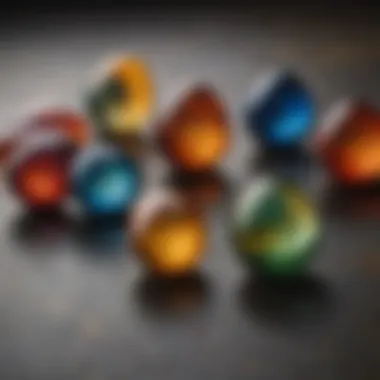
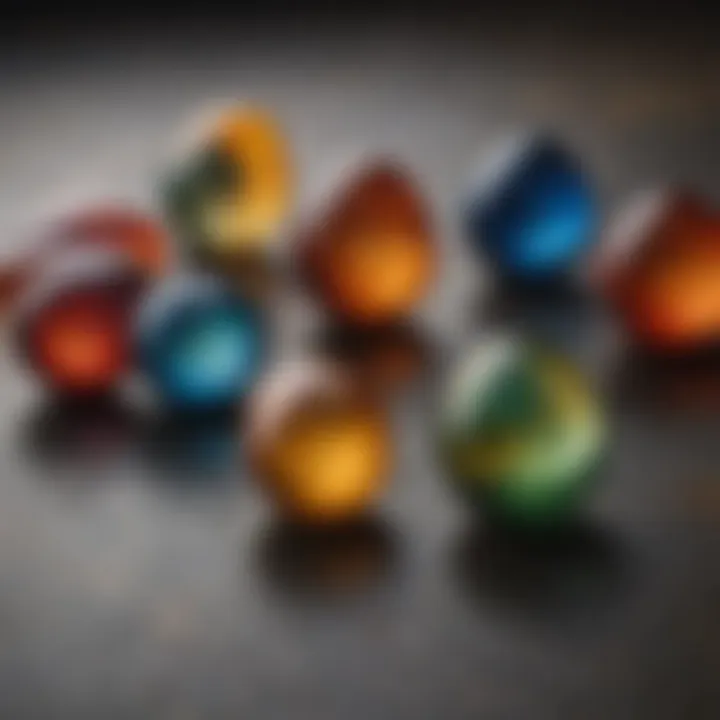
Intro
Teardrop cabochons are unique gemstones that have captivated collectors and enthusiasts alike. Their specific shape, combined with the variety of minerals and materials used in their making, adds a layer of intrigue to these exquisite stones. Beyond their aesthetic appeal, understanding their formation, properties, and cultural significance is essential for anyone in the collectible scene.
This analysis aims to delve deeper into teardrop cabochons, shedding light on their geological origins, how to identify their qualities, and their place within the jewelry-making industry. By doing so, we provide a comprehensive resource that not just informs but enriches the appreciation for these captivating objects.
History and Origins
Overview of Collectibles, Rocks, and Fossils
The fascination with collectibles, especially in the realm of rocks and fossils, can be traced back to ancient civilizations. Gems and minerals have been valued not only for their beauty but also for their supposed mystical properties and cultural significance. Teardrop cabochons, as a specific shape within the larger context of gemstones, reflect a tradition of shaping natural materials into forms that resonate with both aesthetic appeal and symbolic meaning.
Historical Significance and Cultural Impact
Historically, cabochons have been used in jewelry since antiquity. They were often set in gold or silver, adorning the garments of the elite. The teardrop shape is significant across numerous cultures. It symbolizes everything from tears to transformation. Collectors often seek out teardrop cabochons not just for their beauty, but for the stories they encapsulate.
They appeal to a diverse audience that values both their natural origins and their crafted form. The significance of these stones in different cultures can also reflect a deeper understanding of how human beings relate to nature and beauty through collectible items.
Identification and Classification
Guide to Identifying Rocks and Fossils
When exploring the world of teardrop cabochons, familiarity with identification techniques is paramount. Some key characteristics to look for include:
- Clarity: The clarity of a cabochon can sometimes influence its value.
- Cut: The teardrop shape should be symmetrical and well-crafted.
- Color: Vivid and varied colors often appeal more to collectors.
- Inclusions: Nature does not create perfect stones; inclusions can add unique charm.
Common Types and Variations
Teardrop cabochons can be crafted from a range of materials, each offering its own unique properties. Here are a few notable examples:
- Jade: Valued for its beauty and cultural importance, particularly in Asian cultures.
- Agate: Known for its striking layers of color, agate cabochons are popular among collectors.
- Lapis Lazuli: Deep blue hues make lapis lazuli teardrops sought after in the jewelry market.
- Opal: With its changing colors, opal can create eye-catching teardrop cabochons.
"The allure of the teardrop shape is timeless, capturing both attention and admiration across various cultures."
Recognizing these materials and their characteristics helps collectors make informed choices and fosters a deeper appreciation for the skill that goes into each piece.
As we engage further with teardrop cabochons, understanding their role in the jewelry-making process and their care becomes crucial. We will explore these aspects in the subsequent sections.
Foreword to Teardrop Cabochons
Teardrop cabochons represent a fascinating aspect of gemstone appreciation. Understanding these gems requires a close look at their unique qualities, history, and cultural significance. This section serves as the gateway to comprehending the various dimensions of teardrop cabochons. From collectors to designers, grasping their importance will enrich one's experience with these stunning stones.
Defining Teardrop Cabochons
Teardrop cabochons are characterized by their distinctive shape, which resembles a drop of water. This form is not only aesthetically pleasing but also highlights the natural beauty of the stone. A cabochon itself is a gemstone that has been shaped and polished, often with a smooth, rounded surface. Unlike faceted stones, cabochons focus on showcasing color and character. The teardrop shape allows for a graceful display of these attributes.
Cabochons can come in various sizes and types of stones. Common materials include agate, jasper, and onyx. Each type brings unique hues and patterns to the forefront, making them popular among jewelry makers and collectors alike. Teardrop cabochons are often used in pendants, earrings, and other types of jewelry, providing a subtle elegance that can enhance any design.
History of Cabochon Cutting
The practice of cabochon cutting dates back to ancient civilizations. Early jewelers utilized this technique to shape stones that highlighted their vivid colors and designs. Unlike modern faceting, which defines contemporary gemstone cutting, cabochon cutting aims to maintain the integrity of the stone's natural beauty.
Cabochons were essential in trade and adornment throughout history. Cultures worldwide adopted various techniques for working with gemstones. The artisans used rudimentary tools to shape gems, often resulting in intricate designs that complemented the stone’s natural characteristics. Over time, the focus shifted from mere utility to artistry, allowing the craftsmanship to shine through.
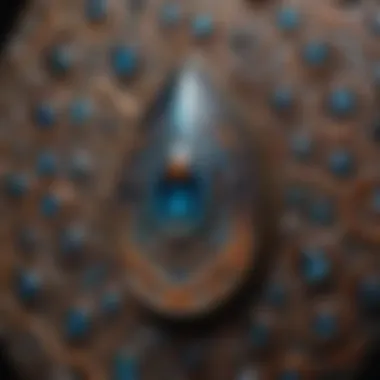
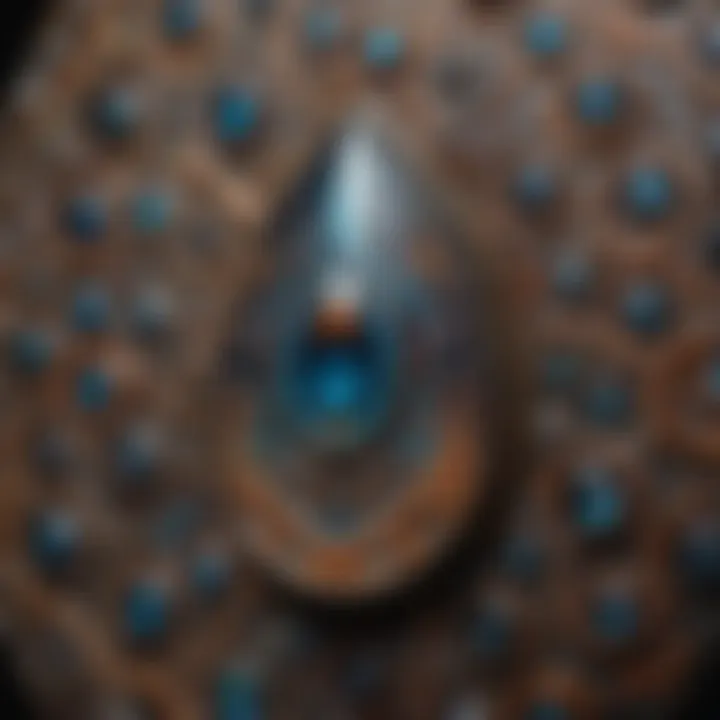
Today, teardrop cabochons continue to carry this rich legacy. They serve as both decorative and functional items in various forms of jewelry. This historical perspective helps collectors appreciate the value and significance of their teardrop cabochons, recognizing them as a bridge between the past and present.
Geological Formation
Understanding the geological formation of teardrop cabochons is critical to appreciate their aesthetic and collectible value. Gemstones are not simply found; they develop through a complex interplay of geological processes. This section outlines the significance of these processes by discussing how various minerals form into cabochons and what makes each one unique.
Understanding Gemstone Formation
Gemstone formation involves various natural processes such as crystallization, metamorphism, and erosion. As mineral-rich fluids travel through the earth's crust, they create various gems under specific temperature and pressure conditions.
The first step in gemstone formation is the crystallization, which can happen in several ways, including cooling magma or evaporation of water. These conditions lead to the solidification of minerals, which may grow inside the earth over millions of years. Afterward, pressure from tectonic movements causes some minerals to transform, generating new varieties of stones.
Additionally, environmental factors like temperature fluctuations and chemical weathering further influence the properties and appearances of gemstones. Collectors benefit from understanding these processes, as they relate directly to a stone's rarity and value. Different gemstones vary greatly in terms of availability, appearance, and hardness, all derived from their unique formations.
Common Minerals in Teardrop Cabochons
Teardrop cabochons can be crafted from various minerals. Each brings distinct characteristics to the finished piece, enhancing its appeal. The most common minerals found in these cabochons include Agate, Jasper, and Onyx.
Agate
Agate is a layered stone formed through volcanic activity. Its unique appearance comes from colored bands or stripes, often seen in vibrant hues. This characteristic makes agate a popular choice for collectors and designers, as it allows for a wide range of patterns and color variations. The stone is relatively hard and durable, which further enhances its suitability for cabochon use. However, potential buyers should be cautious of imitations, as there are synthetic options available on the market.
Jasper
Jasper is an opaque stone known for its rich colors and swirling patterns. It forms in the same volcanic processes but is usually more consistent in texture compared to agate. Due to its availability, jasper often serves as a more affordable option among collectors. Nevertheless, its visual appeal remains high, with pattern variations like picture jasper showcasing scenic landscapes within the stone. The only downside is that jasper can be less durable than other stones, making it vulnerable to scratches if not handled properly.
Onyx
Onyx is a banded variety of chalcedony, recognized for its striking contrasts. The classic black and white onyx provides a bold aesthetic, making it a favorite in jewelry design. Onyx is also relatively durable; however, it is softer than other stones listed here, so extra care is needed to maintain its luster. Collectors often enjoy onyx for its striking look and accessibility, though it is wise to source this stone responsibly to ensure it's not from unethical mines.
Understanding the characteristics of each mineral helps collectors make informed choices, ensuring they select pieces that align with their specific preferences and values.
Characteristics of Teardrop Cabochons
Teardrop cabochons showcase a unique blend of aesthetics and functionality, making their characteristics pivotal in understanding their allure and value. This segment delves into various specific details that define these gemstones, emphasizing their significance for collectors and jewelry makers. From shape to finish, each facet contributes to the overall appeal and marketability of teardrop cabochons.
Shape and Size Variations
One fundamental characteristic of teardrop cabochons is their distinct shape. The teardrop form is characterized by a rounded top that tapers to a pointed bottom, resembling a drop of water. This design is not only visually appealing but also versatile for various types of jewelry settings.
Teardrop cabochons come in different sizes, allowing for flexibility in design applications. Smaller sizes are often ideal for earrings and pendants, while larger pieces may serve effectively in statement rings or brooches. These size variations are crucial since they directly impact the gemstone's perceived value and the intricacies of the crafting process.
When considering teardrop cabochons, collectors should pay attention to the proportions of the gem. A well-balanced cabochon in size and shape enhances aesthetic appeal. Additionally, certain colorations and patterns, combined with the teardrop shape, create unique combinations that may attract collectors seeking rare pieces.
Surface Finish and Transparency
The surface finish of a teardrop cabochon is vital for both its beauty and durability. This aspect includes the polish level, which can range from high gloss to a more matte appearance. A glossy finish generally indicates a well-prepared cabochon, leading to better light reflection and visual attraction.
Transparency is another critical factor. Some teardrop cabochons exhibit complete transparency, while others may be more opaque. Transparency affects how light interacts with the stone, enhancing or muting its inherent colors and patterns. For instance, a transparent agate cabochon allows for stunning variations of color and inclusions to be visible, adding depth.
Furthermore, clarity and the presence of inclusions can significantly alter a gemstone's desirability. Many collectors favor stones that display unique patterns or formations within their transparent layers. These characteristics can be a testament to natural formation processes, making them even more appealing in the collectors’ market.
"Teardrop cabochons capture the essence of nature’s artistry, reflecting the beauty of their geological origins through their diverse shapes and finishes."
In summary, the characteristics of teardrop cabochons, including their varied shapes, sizes, surface finishes, and transparency, contribute immensely to their allure. These factors not only make them desirable in jewelry design but also enhance their value in the collecting world. Understanding these aspects allows collectors to make informed decisions, ensuring their collections are both beautiful and significant.
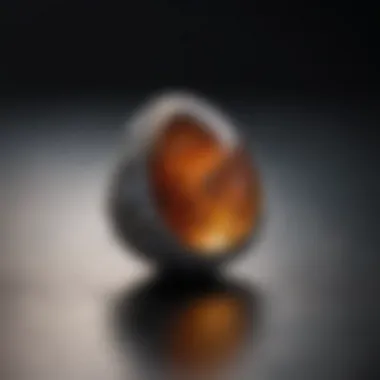
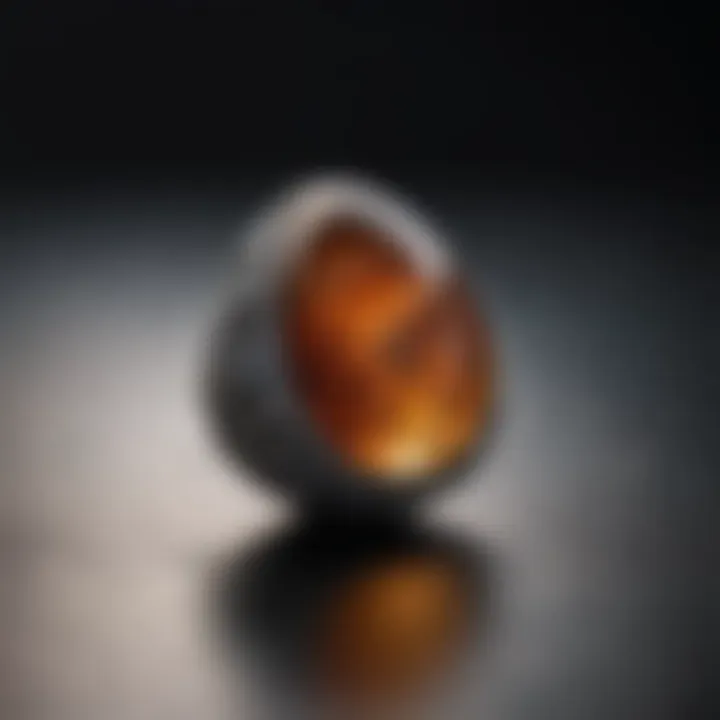
Teardrop Cabochons and Jewelry Design
Teardrop cabochons hold a significant place in the field of jewelry design. Their unique shape and smooth surface allow for diverse applications in various styles of jewelry, from delicate necklaces to bold statement rings. Incorporating these gemstones can enhance the aesthetic of any piece and offer a certain elegance and sophistication. For collectors and jewelers alike, understanding the potential uses and crafting techniques of teardrop cabochons is essential. This section delves into the ways these cabochons can be effectively integrated into jewelry designs, as well as the specific crafting methods that can elevate their presentation.
Incorporating Teardrop Cabochons in Jewelry
The incorporation of teardrop cabochons in jewelry is popular due to their versatility. They can be used in multiple types of jewelry, including earrings, pendants, bracelets, and rings. Their distinct form often draws attention and creates a sense of flow through designed pieces, guiding the viewer’s eye along the contour of the gemstone. This shape complements both casual and formal attire, making it a favored choice among designers.
In addition, teardrop cabochons can symbolize various meanings in different cultures, further increasing their appeal. They often represent tears, emotions, or personal journeys, adding depth to a piece of jewelry. This significance can resonate with collectors who seek not only beauty but also stories behind the gemstones they choose.
Crafting Techniques for Cabochons
Crafting techniques for teardrop cabochons are vital for achieving the desired result in jewelry design. There are two primary techniques to consider: setting techniques and stringing methods. Each has unique characteristics that can impact the overall look and stability of the finished product.
Setting Techniques
Setting techniques involve the ways in which a cabochon is affixed in jewelry. Common methods include bezel settings, prong settings, and wire wrap settings. Each technique varies in how it showcases the cabochon, with bezel settings providing a secure and clean look, while prong settings tend to show more of the gemstone itself, often appealing to those who prefer a more dynamic presentation.
The principal aspect of setting techniques is to ensure security without compromising the gemstone's natural beauty. This characteristic makes these techniques a popular choice, as they can effectively protect the cabochon while allowing light to play across its surface.
A unique feature of bezel settings is that they offer a smooth finish, making them comfortable to wear. However, prong settings, while they expose more of the cabochon, may sometimes leave the stone at risk of snagging or displacement. Overall, the choice of setting technique can considerably influence both form and function.
Stringing Methods
Stringing methods refer to how teardrop cabochons are integrated into necklaces or bracelets. Popular approaches include using silk thread, metal chains, or elastic cords. The chosen method can impact the flexibility and overall style of the piece.
Silk thread offers a softness and elegance, allowing for a more delicate look. Metal chains typically provide a bold statement, enhancing the cabochon as a centerpiece. Elastic cords give versatility but may not support heavier stones effectively.
A unique aspect of stringing methods is that they can alter how the jewelry moves and wears. It’s essential to match the stringing method with the weight and size of the cabochon for durability and comfort. Overall, understanding both crafting techniques enriches the jewelry-making process and ensures that teardrop cabochons are displayed to their full potential.
Collecting Teardrop Cabochons
Teardrop cabochons captivate collectors for numerous reasons. They represent a blend of natural beauty and artisanal craftsmanship. Collecting these stones is not merely a hobby; it is an avenue for appreciation of geological processes and artistic skill. The shapes and colors of teardrop cabochons differ significantly, making each piece unique. Collectors often seek specific stones that not only appeal visually but also carry a story. This narrative could be about the location they were discovered or the process involved in their crafting.
Valuable aspects of collecting teardrop cabochons include their potential for investment. The market for gemstones fluctuates based on quality, rarity, and demand. Understanding what makes a particular cabochon valuable can enhance the collector's experience. Factors like mineral content, cut, and presence of imperfections often determine the price.
Furthermore, collectors gain satisfaction from ethical sourcing and sustainable practices. In recent years, awareness of responsible stewardship in gem mining has grown. Collectors increasingly show preference for stones that come from eco-friendly sources or support local artisans. This not only contributes to better environmental practices but also adds value in the eyes of conscientious consumers.
Overall, collecting teardrop cabochons serves both as a personal journey and a communal engagement with geological beauty. With an understanding of valuation and practices in sourcing, collectors can make informed decisions while expanding their collections.
Valuation and Pricing Factors
Valuing teardrop cabochons hinges on several core factors. First, the quality of the material directly impacts its worth. Stones like agate or jasper might have different pricing trends based on their quality and visual appeal. Teardrop cabochons that exhibit clarity or unique patterns are often more sought after.
Another aspect is the rarity of the stone. Certain colors or formations may be less common, increasing their desirability. For example, a rare blue agate cabochon will typically command a higher price than more common variants.
Additionally, the craftsmanship behind the cabochon is essential. A well-cut stone that showcases good proportions and an appealing polish often brings a better price in the market.
Finally, market demand plays an undeniable role. Trends may shift, influencing what collectors are willing to pay. Keeping abreast of these trends can help collectors make educated purchases and sales.
Ethical and Sustainable Sourcing
The shift towards ethical and sustainable sourcing of gemstones is becoming imperative in today’s market. For collectors of teardrop cabochons, understanding the sourcing of their stones can lead to more responsible collecting practices.


- Transparency: Collectors should seek vendors who provide clear information about the origin of their gemstones. Knowing whether a cabochon was mined ethically can provide reassurance about its impact.
- Support for local communities: Purchasing cabochons from artisans helps ensure that profits go back into the communities from where the stones originate. This practice not only supports local economies but also fosters a sense of trust and value.
- Environmental Impact: Sustainable mining practices can greatly lessen the harm to landscapes and ecosystems. By choosing to buy from responsible sources, collectors can encourage these practices and support biodiversity.
Care and Maintenance
Proper care and maintenance of teardrop cabochons is essential. These pieces, while often beautiful, require specific attention to preserve their luster and integrity. Understanding how to clean and store cabochons can enhance their appearance and longevity.
Cleaning Techniques for Cabochons
Cleaning is critical in maintaining the shine and clarity of teardrop cabochons. The build-up of dirt, dust, and oils can dull their surface.
To clean your cabochons effectively:
- Use Mild Soap and Water: Mix warm water with a few drops of mild dish soap. Avoid harsh chemicals as they can damage the surface.
- Soft Cloth or Brush: Use a soft microfiber cloth or a soft-bristled brush. This helps to gently remove debris without scratching the surface.
- Avoid Abrasives: Do not use abrasive materials. Abrasive pads or rough cloths can cause scratches.
- Gentle Rinsing: After cleaning, rinse with clean water to remove any soap residue. Ensure the water is not too hot, as temperature changes can affect some gemstones.
"Cleaning methods should always respect the specific materials of a cabochon to avoid undesired effects."
Once cleaned, towel-dry the cabochons gently, allowing any remaining moisture to evaporate at room temperature.
Storing Your Cabochons Safely
Safe storage of teardrop cabochons is equally important in their care. Improper storage can lead to scratches or chips, which diminish their aesthetic value.
For secure storage, consider these methods:
- Soft Pouches or Boxes: Invest in soft pouches or lined boxes to prevent direct contact with other stones. This minimizes the chance of scratches.
- Separate Compartments: If possible, store each cabochon in a separate compartment. This provides additional protection from damage.
- Avoid Humidity: Keep your storage area dry. Excessive humidity can lead to mold or damage on the gemstones.
- Temperature Control: Store cabochons in a stable temperature environment. Avoid locations with extreme fluctuations in heat or cold.
These practices not only protect the cabochons but can also enhance their resale value. Proper care ensures that collectors maintain their investment and enjoyment in these unique pieces.
The Role of Teardrop Cabochons in Culture
Teardrop cabochons are more than just aesthetically pleasing objects; they carry significant cultural weight across various societies. These gemstones, with their distinctive shape and smooth, polished surfaces, have been used for adornment and symbolism throughout history. Understanding their role in culture provides insights into human creativity and the connections we hold to the natural world.
Symbolism and Meaning in Various Cultures
In different cultures, teardrop cabochons symbolize a range of emotions and concepts. For example:
- Grief and Loss: The teardrop shape is often associated with tears. In many traditions, wearing a teardrop cabochon can represent mourning or remembrance of loved ones.
- Femininity and Emotion: The feminine form is frequently associated with the idea of nurturing and emotion. Teardrop cabochons' curves often symbolize these qualities.
- Transformation: Some cultures view the teardrop shape as a representation of change or rebirth, reflecting the journey from sorrow to healing.
This depth of symbolism illustrates how a simple gemstone can convey profound meanings.
Modern Interpretations and Trends
Today, teardrop cabochons are not only popular in traditional jewelry but also in modern designs. Artisans and designers continuously innovate by incorporating these cabochons into contemporary pieces. The use of synthetic materials combined with natural stone has led to a diverse palette of colors and patterns.
Some notable trends include:
- Minimalist Jewelry: The simplicity of the teardrop shape aligns well with current minimalist styles. These pieces often highlight the stone itself.
- Healing Crystals: Teardrop cabochons are frequently used in crystal healing practices. Many people believe that the shapes promote positive energy and transformation.
- Bohemian Accessories: The teardrop form is a favorite in bohemian-style jewelry. Its organic shape fits well with artisanal craftsmanship and free-spirited aesthetics.
Epilogue
In the study of teardrop cabochons, understanding the nuances of these gemstones is vital. These stones hold much more than aesthetic value; they embody a connection to geological history and craftsmanship that enriches both personal collections and cultural practices. The knowledge of their formation helps collectors appreciate the natural processes that have shaped these stones over millennia.
The Importance of Understanding Teardrop Cabochons
Teardrop cabochons speak to both beauty and significance. They are often chosen for their pleasing shape and versatility in design. However, there are key elements that collectors must consider when acquiring these unique items.
- Geological Insight: Knowing the geological origins of a teardrop cabochon enhances one’s appreciation for its rarity and beauty. Different minerals lead to variations in color and clarity. For instance, a jasper cabochon can have vivid shades not found in agate, each telling a distinct story.
- Cultural Relevance: Teardrop cabochons appear in various cultures as symbols of emotions, reflections of beliefs, or even as part of traditional adornments. Understanding these cultural meanings can deepen a collector's engagement with their pieces.
- Ethical Considerations: As awareness grows regarding responsible sourcing, a collector must recognize the importance of purchasing ethically mined gemstones. This not only promotes sustainability but also respects the artisans involved in their creation.
- Care Knowledge: Proper care extends the life of cabochons, preserving their beauty. Engaging with care techniques is crucial. This includes adequate cleaning and safe storage to prevent damage.
- Investment Potential: For serious collectors, understanding these factors can influence the valuation of their collection. Knowledge can lead to informed purchases that appreciate over time, aligning personal interest with financial acumen.
Thus, comprehending teardrop cabochons beyond their surface beauty grants collectors a richer experience and appreciation for these gemstones. This understanding fuels a deeper connection not just to the objects themselves, but also to the larger tapestry of history and culture surrounding them.
"Understanding brings value to collection, enriching each piece with a story of its own."



